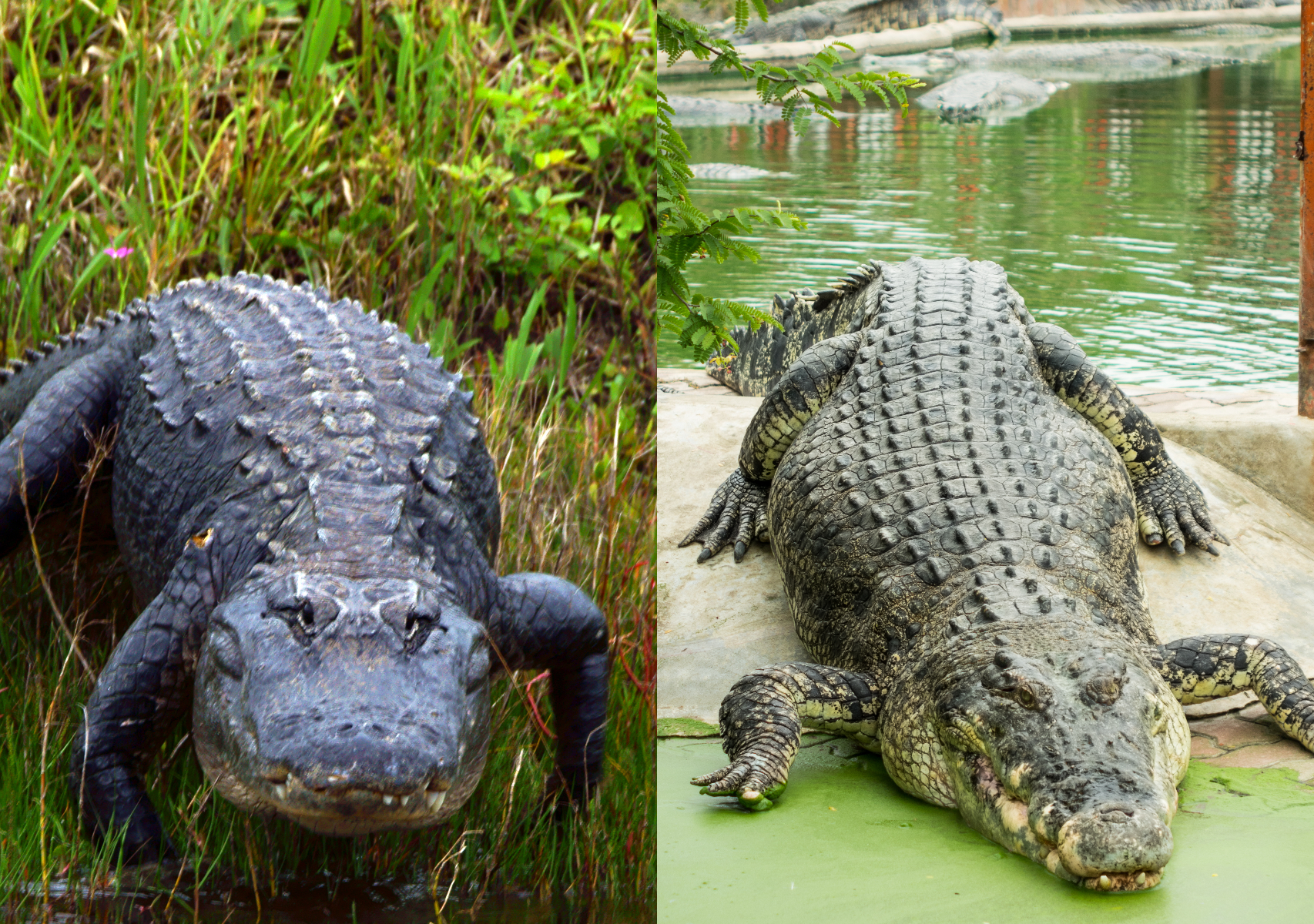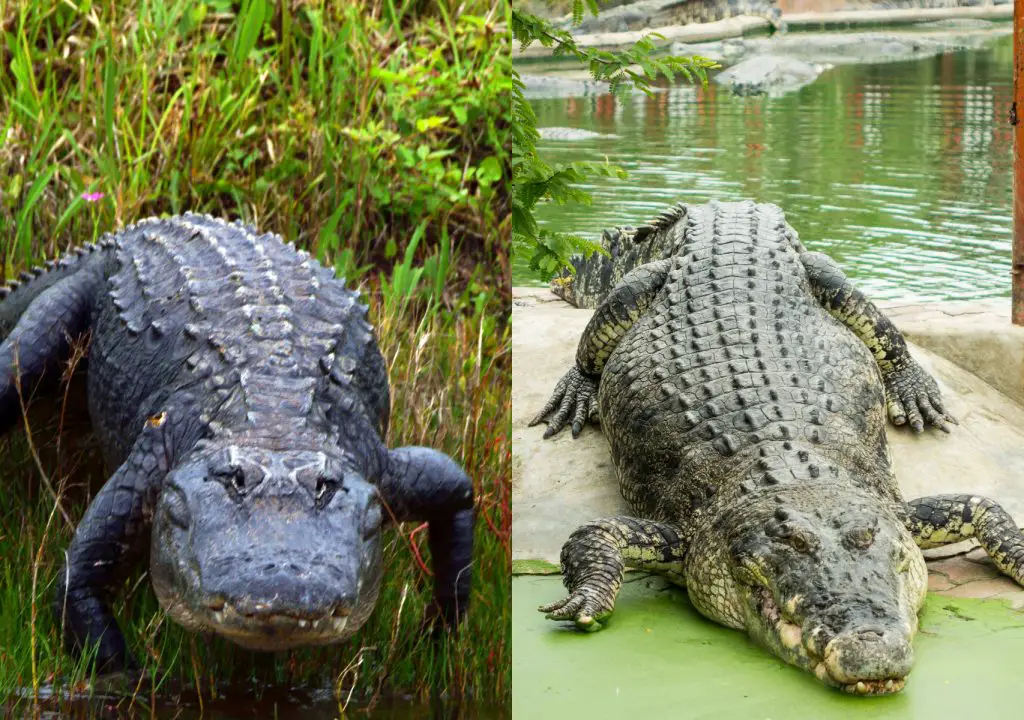Alligators and crocodiles are two of the most fascinating creatures on the planet. They are both fierce predators, and often, people mistake one for the other. But the question remains, who is bigger, alligator or crocodile?
In this article, we will explore the differences between alligators and crocodiles and answer the age-old question of which one is larger. So, sit back, relax, and let’s dive into the world of these incredible reptiles.
Crocodiles are generally larger than alligators. The average crocodile can grow up to 16 feet in length and weigh around 1000 pounds, while the largest alligator ever recorded was just over 19 feet long and weighed 2000 pounds. However, size isn’t the only difference between these two reptiles. Alligators have a wider snout and are generally found in freshwater habitats, while crocodiles have a longer, more pointed snout and can be found in both freshwater and saltwater environments.

Who is Bigger: Alligator or Crocodile?
When it comes to the debate of who is bigger, an alligator or a crocodile, the answer is not as straightforward as one might think. Both animals are large, powerful reptiles that are apex predators in their respective habitats. However, several factors come into play when determining which of the two is bigger.
Size and Weight
Alligators and crocodiles are the largest reptiles in the world, and both can grow to impressive sizes. However, crocodiles are generally larger than alligators. The average size of an adult American alligator is around 10 to 14 feet long and weighs around 800 pounds, while the average size of a saltwater crocodile is around 16 to 23 feet long and can weigh up to 2,200 pounds.
Despite this, there are exceptions to this rule, and some alligators can grow larger than some crocodiles. For example, the largest alligator ever recorded was over 19 feet long and weighed over 2,000 pounds.
Physical Characteristics
While both alligators and crocodiles have similar physical features, there are some key differences that set them apart. Alligators have a broad, rounded snout, while crocodiles have a more pointed, V-shaped snout. Additionally, alligators have a visible upper jaw, while crocodiles have a hidden upper jaw, giving them a more streamlined appearance.
Another distinguishing feature is the coloration of their skin. Alligators have a darker, almost black color, while crocodiles have a lighter, more olive-green color. These differences in physical characteristics make it easier to differentiate between the two species.
Habitats
Both alligators and crocodiles are found in various habitats, such as rivers, swamps, and marshes. However, alligators are mostly found in the United States, while crocodiles are found in many parts of the world, including Africa, Australia, and South America.
The habitats in which they live can also influence their size and weight. For example, alligators living in colder climates tend to be smaller than those living in warmer climates. Similarly, crocodiles living in rivers with limited food sources tend to be smaller than those that live in areas with plenty of food.
Benefits of Alligators and Crocodiles
Both alligators and crocodiles play an essential role in their respective ecosystems as apex predators. They help to control the populations of other animals and maintain the balance of their habitats.
Additionally, their skins are highly valued in the fashion industry, and their meat is consumed by humans in some parts of the world. Alligators and crocodiles are also popular attractions at zoos and theme parks, where people can learn more about these fascinating creatures.
Alligator vs Crocodile: Which is Better?
It’s impossible to say which is better, as both alligators and crocodiles are impressive creatures in their own right. They have unique physical characteristics and play vital roles in their respective habitats.
When it comes to size, crocodiles are generally larger than alligators. However, there are exceptions to this rule, and some alligators can grow larger than some crocodiles. Physical characteristics, such as snout shape and skin coloration, can also help differentiate between the two species.
In the end, whether you prefer alligators or crocodiles, one thing is for sure – these reptiles are awe-inspiring creatures that deserve our respect and admiration.
FAQs
What is the difference between an alligator and a crocodile?
The main difference between an alligator and a crocodile is the shape of their snout. Alligators have a broad, rounded snout, while crocodiles have a more pointed, V-shaped snout. Additionally, alligators have a visible upper jaw, while crocodiles have a hidden upper jaw.
Which is bigger, an alligator or a crocodile?
Crocodiles are generally larger than alligators. The average size of an adult American alligator is around 10 to 14 feet long and weighs around 800 pounds, while the average size of a saltwater crocodile is around 16 to 23 feet long and can weigh up to 2,200 pounds.
What is the difference in habitat between alligators and crocodiles?
Alligators are mostly found in the United States, while crocodiles are found in many parts of the world, including Africa, Australia, and South America. The habitats in which they live can also influence their size and weight.
What is the role of alligators and crocodiles in their ecosystems?
Both alligators and crocodiles play an essential role in their respective ecosystems as apex predators. They help to control the populations of other animals and maintain the balance of their habitats.
Frequently Asked Questions
What is the difference between an alligator and a crocodile?
While both alligators and crocodiles are large, carnivorous reptiles and have similar physical traits, there are some key differences between them. One of the most noticeable differences is their snouts. Alligators have wider, U-shaped snouts, while crocodiles have longer, V-shaped snouts. Additionally, alligators are typically found in freshwater habitats, while crocodiles can thrive in both freshwater and saltwater environments.
Another difference is their geographic distribution. Alligators are native to the Southeastern United States and China, whereas crocodiles can be found in many parts of the world, including Africa, Australia, and South America. Overall, both alligators and crocodiles are fascinating animals with unique characteristics.
What is the size of a typical alligator?
Alligators can vary in size depending on their age and sex. On average, adult male alligators can reach lengths of up to 14 feet and weigh up to 1,000 pounds, while adult females are typically smaller, reaching lengths of up to 10 feet and weighing up to 200 pounds. Young alligators are much smaller and can be as small as 6 inches in length.
It’s important to note that while alligators can grow to be quite large, they are not the largest reptiles in the world. The saltwater crocodile, for example, can grow to be over 20 feet in length and weigh over 2,000 pounds.
What is the size of a typical crocodile?
Crocodiles are some of the largest reptiles in the world. On average, adult male crocodiles can reach lengths of up to 16 feet and weigh up to 1,500 pounds, while adult females are typically smaller, reaching lengths of up to 10 feet and weighing up to 400 pounds. Young crocodiles are much smaller and can be as small as 6 inches in length.
It’s important to note that while crocodiles are larger than alligators, there are still other reptiles that are even larger. The saltwater crocodile, for example, can grow to be over 20 feet in length and weigh over 2,000 pounds.
What are some interesting facts about alligators?
Alligators are fascinating animals with many interesting traits. For example, they have a powerful bite and can exert over 2,000 pounds of pressure per square inch with their jaws. They also have a unique way of communicating with each other using vocalizations, head slapping, and body posturing.
Another interesting fact about alligators is that they can regulate their body temperature by basking in the sun or moving to cooler areas. They also have a special third eyelid that helps protect their eyes while they are underwater. Overall, alligators are complex and impressive creatures.
What are some interesting facts about crocodiles?
Crocodiles are fascinating animals with many interesting traits. For example, they can hold their breath underwater for up to two hours and can swim at speeds of up to 20 miles per hour. They also have a powerful bite and can exert over 3,000 pounds of pressure per square inch with their jaws.
Another interesting fact about crocodiles is that they are social creatures and will often work together to hunt prey. They also have a unique way of caring for their young, with mothers carrying their babies in their mouths or on their backs. Overall, crocodiles are impressive and unique animals.
ALLIGATOR VS CROCODILE – Which is More Powerful?
In conclusion, the question of who is bigger, the alligator or the crocodile, does not have a straightforward answer. Both species can grow to impressive sizes, with some individuals reaching lengths of over 20 feet. However, when it comes to pure size, the saltwater crocodile is the largest reptile in the world, with adult males weighing as much as 2,200 pounds.
Despite their differences in size, both alligators and crocodiles are formidable predators in their own right. They have powerful jaws, sharp teeth, and can move quickly both on land and in water. However, they also play important ecological roles within their respective habitats and are worth protecting.
In the end, the debate over which species is bigger may continue, but what is clear is that both alligators and crocodiles are fascinating creatures that deserve our respect and admiration.


